Oct 29
2014
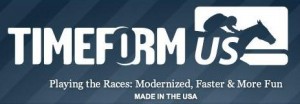
In a prior article we introduced TimeformUS and a list of our favorite features. Click here to read that article.
Included in our list of favorite features was “expanded trip notes.” In addition to these, TimeformUS offers additional “Perspective Comments” that are available for the majority of races that were run in Europe. These comments are extensive and quite often provide more than just trip related information. For example, sometimes there are comments that reflect the quality of the competition in the race and/or prior races. At other times, there are comments about where the horse is headed next, whether or not the horse is suited to try different distances, go up in class, etc. With the influx of European horses for the Breeders’ Cup, this type of information can provide the horseplayer with an edge over players who do not have access to these comments.
Read More >>
Oct 27
2014
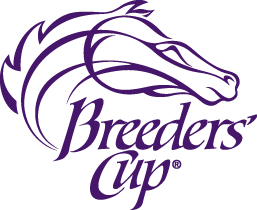
In a prior article we introduced the Art of Visual Handicapping and included an example from the 2013 Breeders’ Cup. Click here to read that article.
In this article we are going to put the spotlight on four horses running in the 2014 Breeders’ Cup and explain what caught our attention when watching some of their video race replays.
Before we show the videos, there is one caveat: We are not making any selections (picks) in this article. The videos were chosen because we felt they represent a good example of the concepts covered in the article on visual handicapping. Hopefully you can incorporate what you learn from each video into your thought process, and in the end, make a better selection. Also, we hope that these examples will give you ideas for things to look for when you are watching race replays of other horses involved in the Breeders’ Cup.
Read More >>
Oct 24
2014

In a prior article we provided an overview of Santa Anita turf course and how it’s unique configuration might impact the running of Breeders’ Cup races in 2014. Click here to read that article.
In this article we are going to cover the Santa Anita dirt track, and although it isn’t quite as unique as the turf course, there are still factors to consider for each distance run in the Breeders’ Cup races.
For example, where is the starting gate position for each race? How close is it to the first turn? Is there an advantage to inside or outside post positions at each distance? How does the Santa Anita track layout compare to other racetracks?
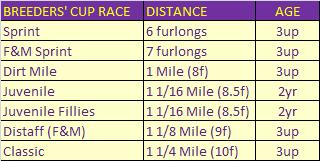
Breeders’ Cup Dirt Races
To the right is a table listing the Breeders’ Cup dirt races that will be contested at the various distances. You can see that other than the two Juvenile races, every other distance is only run once for Breeders’ Cup races.
For some distances, the location of the starting gate is very similar to other racetracks. For other distances, it is much different … even when the size of the oval (1 mile) is identical to that of Santa Anita.
Read More >>
Oct 23
2014
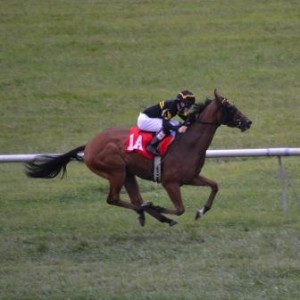
We classified this article under the “Trips” category, but in fairness it involves much more than the “good” or “bad” trip approach to handicapping. Trip handicappers are always on the lookout for circumstances where a horse ran worse than expected, but had one or more excuses that explain their sub-par performance. This can offer value when other bettors jump off that horse’s bandwagon.
On the flip side, discovering that an above average performance was bolstered by a favorable trip can offer value on other horses in an upcoming race. For example, maybe a horse benefited from a speed duel, and was sitting in the “garden spot” immediately behind dueling leaders who tired dramatically in the stretch. If circumstances in his next race are different, he might not fare so well.
Read More >>
Oct 19
2014

Breeders’ Cup 2014 is right around the corner, and we thought it would be a good time to feature an article about the unique layout of the Santa Anita turf course and how it might impact the running of the Breeders’ Cup races this year.
We will limit our review to include only the four distances of Breeders’ Cup races contested over the turf course. To begin, we will show a diagram of the turf course layout and include the starting gate position (in colored boxes) for each distance included in the 2-day set of Breeders’ Cup races. And we will discuss how post positions are affected by the location of the starting gate and it’s proximity to the first turn at each distance. Distances of 1-mile or more show the furlong equivalent for individuals (like myself) who think in terms of furlongs.
Read More >>
Oct 10
2014
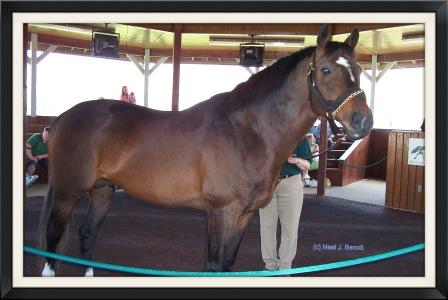
Champion CIGAR, retired in Kentucky
In a prior article we explained the various Age restrictions that occur in every thoroughbred horse race. They include 2-year old only, 3-year old only, 3 years old and upward, and 4 years old and upward. We also provided examples on how this information is presented in the Daily Racing Form. Click here to review that article.
In this article we are going to consider a strategy you can employ when factoring Age into your handicapping process. It might seem like common sense, but Age is one of those little details that sometimes gets lost in the handicapping process. For example, there have been many times when looking back at a race, I’ve noticed “Hey, the winner was the only 4-year old in the race.”
Read More >>
Oct 7
2014
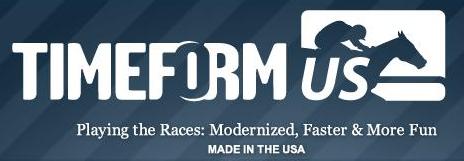
In a prior article we introduced TimeformUS as “The new racing form in town!” Click here to read our overview of TimeformUS and our list of top ten features. Included in the list of features we provided was “Speed figures that incorporate pace into the calculation.” In this article we will explain TimeformUs speed figures and provide an example of a specific race at Saratoga to illustrate how they differ from Beyer Speed Figures.
The race we will be using in our article is the Grade 2, Bernard Baruch Handicap run at Saratoga on August 30,2014. The race was run at a distance of 11/16 mile (8.5 furlongs) over a firm turf course. We are going to focus on the resulting TimeformUS speed figures for three horses in this race. The horses are Sayaad (#9), Optimizer (#2), and Wise Dan (#4).
In order to better understand our explanation of the speed figures, it will be quite helpful to watch the video replay of the race and take note of the race call provided by Tom Durkin and the position of our three horses during the running of the race. Below is the video race replay.
Read More >>
Sep 16
2014
In a prior article we discussed the dynamics of a horse “stretching out” from a short race (sprint) to a longer race (route). In particular, we covered the paradox that often occurs when a horse closes in a sprint race, comes up short, and appears to just “need a little more ground.” Click here for review of that article.
In that article we provided an example of a horse named Pan Dulce, who finished 2nd in a 6-furlong race at Belmont, and subsequently was the 9-5 favorite in an 8-furlong race at Saratoga. Unfortunately, for supporters of this horse, she tired in that race and was a well beaten 3rd. But, the story doesn’t end there, and in fact her next move back into a sprint race provides material for the cutback angle. Read More >>
Sep 5
2014

In a prior article we introduced TimeformUS as “the new racing form in town!” Click here to read our overview of TimeformUS and our list of top ten features. In this article we will explore their Trainer Ratings and spot check a few specific examples in an attempt to verify their rating numbers. Before we do that, let’s explain the TimeformUS ratings system when it comes to trainers.
Below is an sample of a TimeformUS display for North American trainer, George Weaver.

Read More >>
Aug 21
2014
A frequent question asked by new fans trying to learn more about horse racing is, “Where do I begin?” My immediate response is generally, “Get to know your trainers.” While learning about topics like distance, class, and pace are important … in my opinion, none are as important as learning about the tendencies, strengths, and weaknesses of trainers. With that thought in mind, we continue our series of articles called “Know Your Trainers.”
In this series we will dig into the statistics of some head trainers and try to make sense of the numbers we find. We thought it might be fun to present the numbers in a “competitive” manner by pairing trainers. With that said, we are not trying to judge the trainers or claim that one is better than another. Our intention is to pair trainers who have statistics in comparable categories and present some plausible reasons why they might differ.
So let’s continue with two of the big names in the business, Shug McGaughey and Chad Brown. Our focus will be on two main areas; Graded Stakes and 2-Year old horses, with a couple of extras that we uncovered by surprise. We limited the data to the past two years, with the exception of Graded Stakes Dirt races for Shug, where we included three years to get a comparable data sample.
Read More >>







